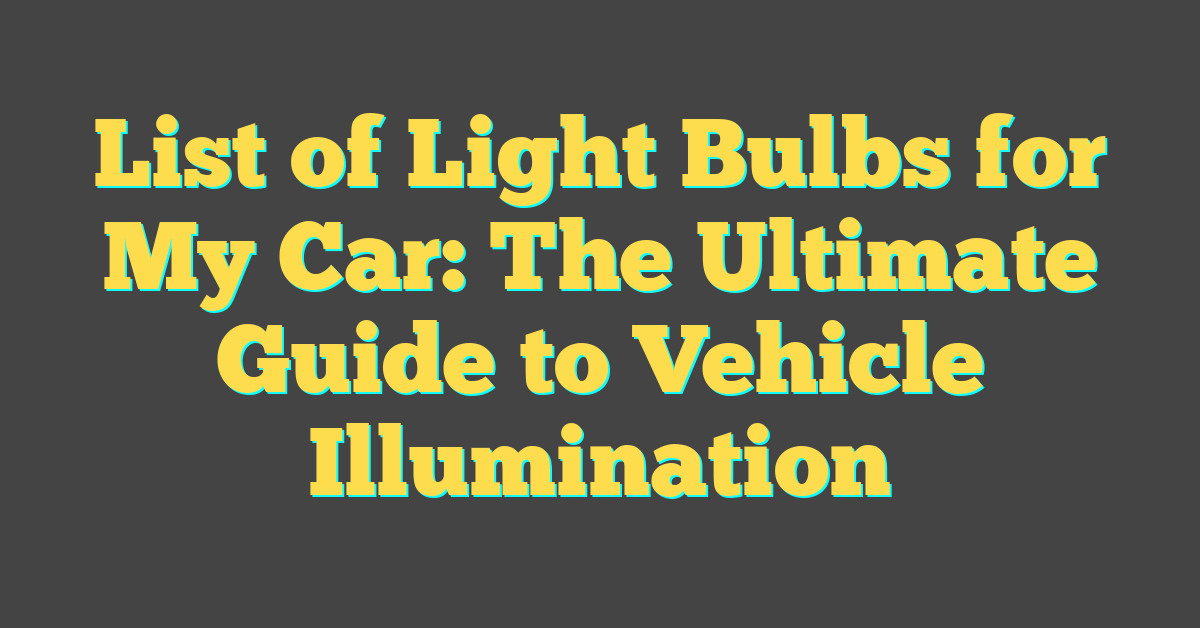Finding the right light bulbs for your car is essential for safety, legal compliance, and personal preference. Your vehicle relies on various light bulbs to illuminate the road ahead, signal to other drivers, and increase your visibility under different conditions. From headlights to tail lights and everything in between, there is a specific bulb for every function. But with so many types on the market, it’s important to know which bulbs will fit your car and meet your driving needs.


Selecting the correct bulbs can seem daunting, but it becomes straightforward once you comprehend the basics. Knowing the difference between halogen, LED, and HID bulbs, as well as understanding their brightness and color specifications, will help you make an informed decision. It’s not just about replacing a burnt-out bulb; it’s about choosing the right light that ensures optimal performance and safety for your vehicle.
Key Takeaways
- Proper selection of car light bulbs enhances safety and vehicle functionality.
- Understanding bulb types and specifications ensures the right fit and performance.
- Regular maintenance and timely replacement of bulbs keep your vehicle’s lights optimal.
Understanding Light Bulb Basics
https://www.youtube.com/watch?v=Ei5vS-g4DTo&embed=true
When selecting the right light bulbs for your car, it’s crucial to understand the various types available and the importance of choosing the correct size and fit. Knowledge of these aspects ensures that you maintain legal compliance and optimal visibility on the road.
Types of Car Bulbs
Halogen Bulbs: Your vehicle is most likely equipped with halogen bulbs if it’s a model from the last few decades. These bulbs contain a tungsten filament and are filled with halogen gas, which helps increase both the lifespan of the bulb and the brightness of the light.
LEDs (Light Emitting Diodes): On the other hand, LED lights are increasingly popular for their long life and energy efficiency. They produce light when an electrical current passes through a semiconductor.
Bulb Size and Fit
Finding the Correct Size: The specific bulb size for your vehicle is essential to ensure proper fit and function. You can identify the right headlight, tail light, and fog light bulb sizes by referring to your car’s manual or using an online automotive bulb finder.
Compatibility: Not all bulbs will fit every vehicle, so it’s important to know whether your car supports LEDs or is equipped for halogen light bulbs. Additionally, upgrading from halogen to LED might require additional components or adjustments.
Selecting the Right Bulbs by Vehicle

When it’s time to replace or upgrade the bulbs on your car, knowing the specific bulb size and type for your vehicle is essential. Whether you’re dealing with headlight, tail light, or signal lights, using the correct bulb ensures a perfect fit and proper function.
Automotive Bulb Finder
Using an Automotive Bulb Finder simplifies the process of finding the right bulb for your car. By entering key details such as your car’s make, year, and model, this tool filters through a database to present you with the bulb options compatible with your vehicle. The tool takes into account the variances in bulb requirements across different car manufacturers and models, ensuring you get a match that’s as accurate as possible.
Make and Model Specifics
When searching for the right bulb, your car’s make and model are as important as the year it was manufactured. Some manufacturers may change their bulb specifications for newer models or during mid-year production changes. For instance, a 2015 Honda Civic might use different bulb types from a 2016 model even though they belong to the same model lineage. It’s vital to check the exact year, make, and model when selecting bulbs, as using this precise information will guarantee that the bulb will fit perfectly and perform as intended.
For ease of reference, keep your vehicle’s manual handy as it typically lists bulb sizes for various light fixtures. If the manual is not available, an online search for your specific vehicle’s bulb guide or visiting a specialized site like Car Light Bulb Size List can quickly lead you down the right path.
Headlight Bulb Replacement
https://www.youtube.com/watch?v=HO3IXM3XkUU&embed=true
« Cheap Light Bulbs Australia: Top Picks for Budget-Friendly Illumination
Free Light Bulbs Oregon: How to Brighten Your Home at No Cost »
Replacing your vehicle’s headlight bulbs can improve visibility and safety on the road. In this section, you’ll learn how to select the best replacement bulbs for your car and how to install them properly.
Choosing Headlight Bulbs
When choosing replacement headlight bulbs, you have a variety of options based on brightness, color, and life expectancy. For high-intensity discharge bulbs, D1S HID headlight bulbs provide a bright, white light and can be a solid choice if they’re compatible with your vehicle’s lighting system. If you prefer LED bulbs, 9006/HB4 LED headlight bulbs are known for their longevity and energy efficiency. It’s essential to check your vehicle’s manual or use an automotive light bulb finder to ensure you select the correct bulb type and size.
- Types of Headlight Bulbs:
- Halogen: Most common, offering standard brightness and color.
- LED: Longer lifespan, cooler operation, and increased brightness.
- HID: Produce brighter light and greater range than halogens.
Before purchasing, consider how the bulb’s color temperature impacts your visibility in different driving conditions.
Headlight Bulb Installation
Installing new headlight bulbs is a task you can often do yourself. Make sure the car is turned off and the headlights are cool before starting. Your car’s manual will provide specific instructions, but generally, you’ll access the back of the headlight assembly, detach the power connector, remove the old bulb, and replace it with the new one.
- Turn off your vehicle and ensure the headlights are cool.
- Open the hood and locate the back of the headlight assembly.
- Detach the power connector from the old bulb.
- Unlock and remove the old bulb carefully.
- Install the new bulb without touching the glass.
- Reconnect the power connector and ensure the bulb is secure.
Review a headlight replacement guide to help you through the process step by step. Remember, handling the bulb’s glass with bare hands can shorten its lifespan due to oils from your skin. Using gloves can prevent this issue. Always verify the new bulb is working correctly after installation.
Tail and Brake Lighting
https://www.youtube.com/watch?v=EKmcbHlz6zA&embed=true
Tail and brake lights are essential for your safety on the road, allowing other drivers to see your vehicle from behind, especially at night or during poor weather conditions. It’s important to ensure these lights are always functioning properly.
Tail Light Bulb Types
Your vehicle’s tail lights typically employ one of several types of bulbs. The most common types are:
- Halogen: Affordable and widely available, they offer standard brightness but have a shorter lifespan.
- LED: These bulbs are more energy-efficient, have a longer lifespan, and provide brighter illumination.
- HID (High-Intensity Discharge): HID bulbs are brighter and last longer than halogen bulbs but are typically found in newer, high-end vehicles because of their higher cost.
To check what type of bulb your car uses for its tail lights, you can refer to the Automotive Light Bulb Finder for guidance based on your vehicle’s make and model.
Replacing Tail Light Bulbs
When replacing your tail light or brake light bulb, it’s best to do them in pairs. Here’s a simple guide for replacing these bulbs:
- Safety First: Ensure your vehicle is switched off, and keys are removed from the ignition.
- Accessing the Bulb: Open your trunk or hatchback to access the tail light assembly. Remove any covers or screws as needed.
- Remove and Replace: Gently remove the burnt-out bulb by twisting it counterclockwise. Replace it with the new bulb by twisting it clockwise until secure.
- Testing: Before reassembling, turn on your lights and press the brake pedal to ensure the new bulb is working.
Keep in mind that some vehicles may have a different process, and consulting your owner’s manual or a professional service like the Sylvania Automotive Bulb Replacement Guide may help with specific instructions for your car model. Always handle bulbs with care, as oils from your skin may decrease the lifespan of the bulb.
Specialty Lighting

When selecting specialty lighting for your car, you’ll find options that not only enhance your vehicle’s appearance but also improve visibility in various driving conditions. Here, we’ll discuss the specific benefits and functions of fog lights and daytime running lights, as well as the importance of signal and position lights for safety and compliance with traffic regulations.
Fog and Daytime Running Lights
Fog Lights: Designed to illuminate the road directly in front of your vehicle, fog lights are particularly useful in poor visibility conditions caused by rain, fog, dust, or snow. They are mounted low on your vehicle to prevent light from reflecting off the fog and causing glare.
- Daytime Running Lights (DRL): These lights make your vehicle more visible to others during the day. Daytime running lights are automatically switched on when the car is in motion, signaling your presence to other drivers, thus reducing the chances of daytime accidents.
Signal and Position Lights
Signal Lights: Also known as turn signals or blinkers, signal lights alert other drivers of your intention to change direction. Ensuring these lights are functioning correctly is crucial for your safety and is a legal requirement.
- Position Lights: Your car’s position lights, sometimes referred to as parking lights, help other drivers see the size and position of your car in low visibility situations. They are especially useful when your headlights are off, but you still need to mark your car’s presence on the road.
Remember, proper maintenance of these lights is key to your road safety. Always ensure they are working correctly and replace them with the correct type of bulb when necessary.
Interior and Dashboard Lighting
https://www.youtube.com/watch?v=fjEhiDwb1H0&embed=true
When it comes to maintaining the inside of your car, both your interior lights and dashboard lights play critical roles in ensuring safety and comfort during your travels. Choosing the right bulbs can enhance visibility and the overall driving experience.
Interior Light Replacement
Your car’s interior lighting allows you to see inside your vehicle at night and can be essential for both functionality and aesthetics. When replacing these bulbs, first identify the type you currently have; options typically include traditional halogen, LED, or xenon bulbs. To upgrade your interior car lights, check the bulb type and size specific for your vehicle—often found in the owner’s manual or an online bulb finder like the Sylvania Automotive Bulb Replacement Guide. Replacing them can be a simple process:
- Locate the light fixture.
- Carefully remove the cover; this may require a flat tool.
- Replace the old bulb with the new bulb, matching the type and size.
- Securely replace the cover.
Dashboard Light Considerations
Dashboard lights illuminate vital information on your car’s control panel and need to remain in optimal condition. It’s important to choose bulbs that provide a balance between brightness and readability so as not to interfere with your visibility on the road. Symbols and gauges must be clearly visible without causing glare. Factors to consider can include:
- Bulb Type: LEDs might offer longer life and better energy efficiency.
- Brightness: Ensure replacements are not overly bright as they may distract or impair nighttime driving vision.
- Color: Some drivers prefer certain colors for better clarity or personal preference, but always ensure they comply with road safety standards.
Regular checks on these lights are important, and if you notice a dashboard light dimming, it’s wise to replace it promptly. Remember, consistent brightness between all instruments aids in legibility and overall safety.
Understanding Brightness and Color
https://www.youtube.com/watch?v=X9Q8GcnoFfg&embed=true
When you’re upgrading or replacing your car’s light bulbs, understanding their brightness and color is crucial. Brightness affects how well you see at night and color temperature can influence driving comfort.
LED Brightness
LEDs, or Light Emitting Diodes, are known for their superior brightness and efficiency. They produce a brilliant, white light that can enhance your visibility on the road. Comparing LED brightness is often done using lumens, which measures the total quantity of visible light emitted by a source. Here’s a straightforward breakdown:
- High Brightness: LEDs typically range from 2000 to 4000 lumens, with some high-powered options even brighter.
- Energy Efficient: Despite their brightness, LED lights consume less power, potentially extending your car’s battery life.
Halogen Color Temperature
Halogen bulbs are rated by their color temperature, in degrees Kelvin (K). Their spectrum can vary from warm yellow to cool blueish hues.
- Warm Light: A typical halogen bulb emits a warm yellow light, around 2700K to 3000K, which is comfortable for night driving.
- Cooler Spectrum: Higher color temperatures (above 4000K) provide a cooler, blueish light that resembles daylight but is not necessarily better for visibility or safety.
Remember, your choice in bulb brightness and color temperature not only affects your own visibility but also how other drivers perceive your vehicle on the road. Choose wisely to ensure a balance between performance and safety.
Advanced Bulb Technologies

When you’re looking to upgrade your vehicle’s lighting, advanced bulb technologies provide you with brighter and more efficient options. The latest developments in Xenon HID and LED lighting can enhance your driving experience.
Xenon HID Lights
Xenon High-Intensity Discharge (HID) lights offer a bright, white glow, using xenon gas to produce light. These headlights last longer than traditional halogen bulbs and are more efficient, giving you clear visibility on the road at night. They require a bit of time to reach full brightness, but once they do, your path will be well-lit.
New LED Innovations
LED lights are leading the way with significant advancements in automotive lighting. Unlike Xenon HIDs, LED lights turn on instantly and can be designed in a variety of shapes, allowing for creative and flexible styling of your vehicle’s lights. They’re also energy-efficient and have a long lifespan, which makes them cost-effective in the long run.
Troubleshooting Common Issues
https://www.youtube.com/watch?v=c9cpQCUIB_E&embed=true
When you encounter issues with your car’s lighting, knowing how to troubleshoot can save you time and money. Here’s how you can tackle two of the most common problems you might face with your car’s light bulbs.
Flickering Lights
If your car’s lights are flickering, it could be due to a few reasons. Start by checking for loose bulbs or corroded connections. Tighten any loose bulbs and clean off corrosion with a bit of sandpaper. If flickering persists, there might be an issue with your alternator’s voltage output, which should be above 13.5 volts. Consider having your alternator checked for consistent power supply.
Premature Bulb Failure
In cases of premature bulb failure, make sure you are using the right bulb type and wattage for your vehicle. Incorrect bulbs can lead to frequent burnouts. Also, always handle bulbs by the base to avoid transferring oil from your skin to the glass, which can cause the bulb to fail early. If bulbs continue to fail, inspect the headlamp for any signs of electrical problems, like a faulty ignition switch connection that might need professional attention.
Manufacturers and Brands

When you’re looking to replace or upgrade the light bulbs in your vehicle, you have a wide array of manufacturers and brands to consider. Each offers various options that may be suited for your car, SUV, truck, or van, from luxury makes like Lexus and Audi to more common brands like Ford and Honda.
Popular Light Bulb Brands
Here’s a list of some well-known light bulb brands you might encounter:
- Sylvania: Renowned for a broad range of automotive lighting solutions.
- Philips: Offers innovative and durable headlamps for vehicles.
- AUXITO: Known for their LED bulbs, catering to a variety of car models including but not limited to Chevrolet, Dodge, and BMW.
- GE Lighting: A classic option with reliable products for many different vehicles.
Choosing Quality Manufacturers
When selecting a bulb for your vehicle, consider these points focusing on the quality and compatibility:
- Quality and Reputation: Brands like AUXITO and Sylvania have developed a reputation for quality and dependability. Apart from broad-range manufacturers, specialized brands may offer more advanced technology or longer-lasting bulbs.
- Vehicle Compatibility: Ensure that the manufacturer produces bulbs compatible with your car’s make and model. Whether you drive an Acura, Alfa Romeo, or Mercedes-Benz, checking compatibility is crucial. You’ll find that brands like Philips and GE Lighting provide extensive options for numerous vehicle makes, including Kia, Mazda, Nissan, and more.
Remember, investing in quality light bulbs from reputable manufacturers means better performance and often a longer lifespan for the bulbs in your vehicle.
Installation and Maintenance Tips

Replacing your car’s light bulbs is an important part of vehicle maintenance that ensures you have proper visibility during your drive. Here are some focused tips on installing new bulbs correctly and extending their lifespan.
Proper Installation Techniques
When it’s time to replace your auto light bulb, always refer to your vehicle’s handbook for the specific bulb type your car needs. It’s essential that the replacement matches the original bulb designation, such as 501, H1, H4, or H7. When handling bulbs, especially halogen types, do not touch the glass with your bare hands because oils from your skin can shorten the bulb’s lifespan. Make sure to check the bulb’s positioning in the assembly to ensure it’s seated properly, which will prevent issues related to vibration and beam focus.
Extending Bulb Lifespan
To extend the life of your car’s light bulbs, cleanliness is key. Dirt and residue can accumulate on the bulbs, causing them to dim prematurely, so wiping them with a soft cloth or microfiber towel will maintain their brightness. For maintenance, regularly check your engine’s alternator output, as a fluctuating or excessive voltage can reduce bulb life. Additionally, consider replacing both bulbs in a pair even if only one has failed; this ensures consistent luminosity and color from headlights, contributing to safer driving conditions.




